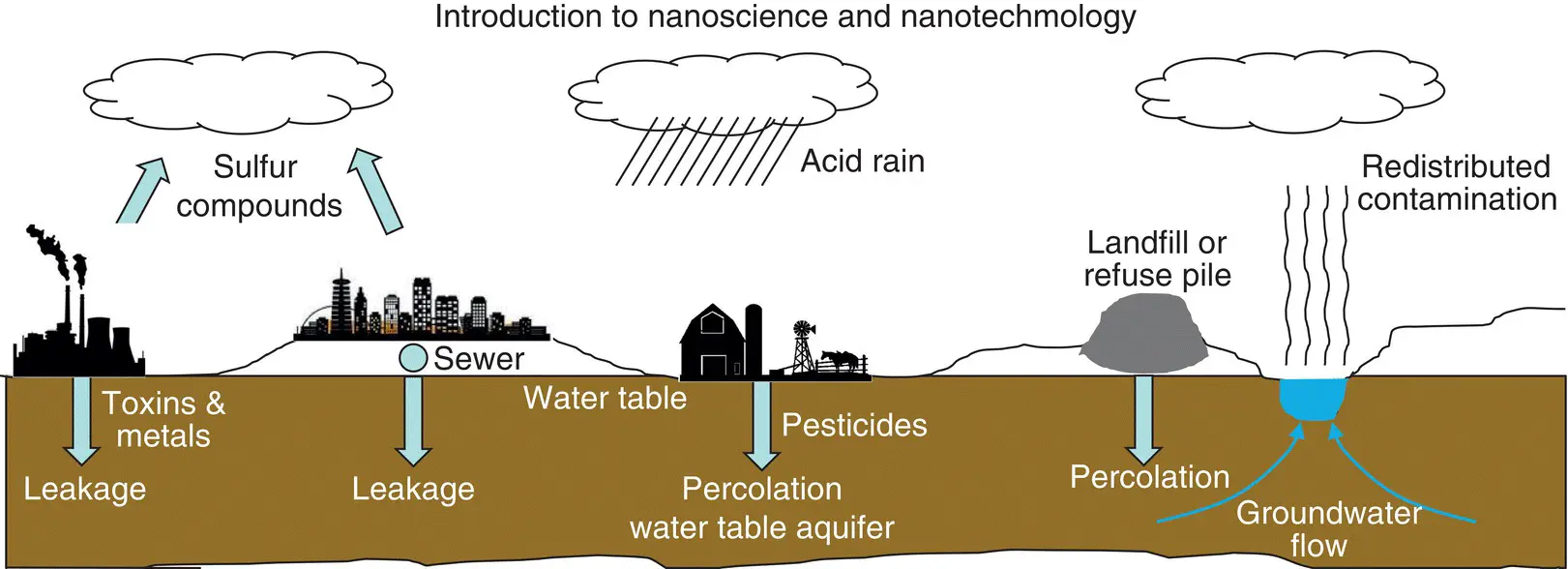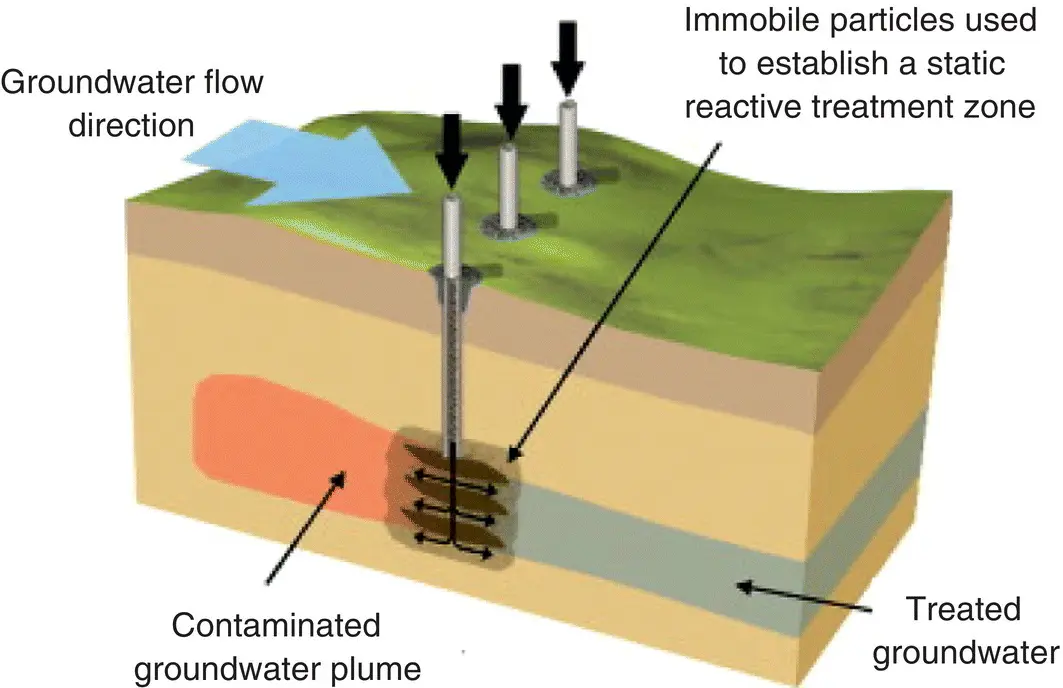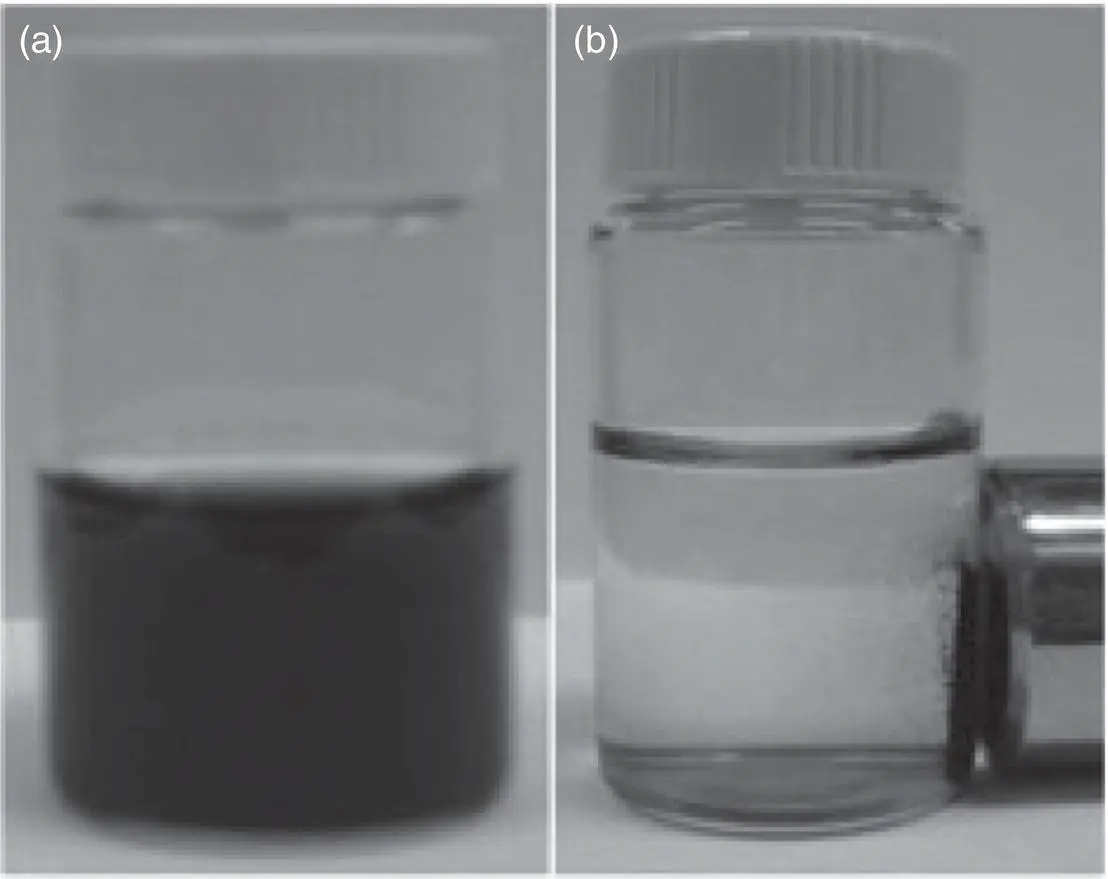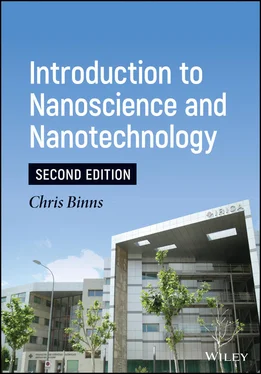(b) Atomic force microscope (AFM) image of a single ~1 μm dust particle from the comet showing that it is composed of smaller particles.
Source : Reproduced with the permission of the Nature Publishing Group from [23].
2.7 Environmental Applications of Nanoparticles
The chapter so far has focused on naturally occurring nanoparticles or those produced as a by‐product of human activity. In this final section, the use of nanoparticle technologies to address environmental issues will be described with reference to two examples, that is, removing toxins from water and recycling of plastics.
2.7.1 Water Remediation Using Magnetic Nanoparticles
Figure 2.15shows some examples of how anthropogenic activities can pollute the soil beneath the water table including urban run‐off, farming, industry and waste disposal. Sulfur‐containing emissions can also enter clouds and be rained back in the form of acid rain while the mobile water beneath the surface enters rivers and the evaporated material enters clouds so that the pollution is redistributed over the land. Plants take up the contaminants, which can then enter the food chain or the pollution can accumulate in fish, which are subsequently eaten by humans as in the notorious case of mercury poisoning in Japan in 1956 with over 2000 victims [24]. The most common pollutants are heavy metals and organic compounds and even very low contamination levels in the ng/l range can lead to cancers, respiratory infections, and skin diseases.
Soil and groundwater remediation to reduce toxins to safe levels is thus an important activity and traditionally, water is cleaned using filter beds. For severe or toxic contamination, the use of nanoporous filters, which present a very large active surface to remove contaminants per unit volume of filter, is more effective. An issue with these, however, is the slow volume flow rate through them and more recently there has been great interest in an alternative approach, which is to present the large surface area as a dispersal of nanoparticles within the contaminated water.

Figure 2.15 Pollution of soil and groundwater by anthropogenic activities.Releases by factories, urban run‐off, farming and waste disposal all introduce contaminants into the soil. In addition, sulfur compounds released into the air enter clouds and are re‐deposited as acid rain. The flow of groundwater in the water table aquifer introduces the contaminants into waterways, which become a source of redistribution.
The most popular type of magnetic nanoparticle is so‐called nano zero‐valent iron (nZVI), which can be produced chemically on a large scale with a relatively simple reaction [25]. The zero‐valent label is used to denote unoxidized or pure metallic iron but the metal is so reactive that the formation of an oxide shell during synthesis is unavoidable. This, however, is beneficial to some processes and it protects the core from rapid oxidation, though the oxide will, over time, eat into the core. Under certain applications, the magnetic nanoparticles can be separated from the water using an applied magnetic field.
The nZVI removes contaminants by forming compounds with them and bonding them to the surface of the nanoparticles, which is greatly facilitated by the large surface area presented. This is typically 25 m 2/g for commercially available nZVI powders but can reach 100 m 2/g (see Problem 1, Chapter 1). The freshly synthesized nZVI particles have a thin porous oxide shell that allows contaminants to get very close to the iron/oxygen interface where the reactions take place. As they work, the nanoparticles get coated by a shell of the reaction products and eventually become inactive. The first demonstration of the method was in 1997 where it was used to remove chlorinated organic toxins [26] but since then it has been shown to clear a range of contaminants from groundwater including antibiotics, dyes, solvents, pesticides, metals, and radioactive isotopes. For a comprehensive list of contaminants removed see [27].
A common method of application is illustrated in Figure 2.16for the case of mobile groundwater requiring a static filter. After assessing the geological conditions at the site to decide on the density of nanoparticles required, boreholes are drilled to the required depth and the nVZI powder mixed with water is introduced as a slurry under pressure. This permeates the aquifer (the layer of water‐bearing permeable rock) and forms a static filter through which the groundwater flows. In some applications, it may be more appropriate to inject mobile nanoparticles into the water flow where they are carried to the source of pollution.
The discussion has focused entirely on the chemical properties of iron without considering its magnetism, which, in principle, provides a simple mechanism to separate the contaminant‐holding particles from the water. In the presence of a magnetic field gradient, dB / dz , a magnetic particle with a magnetic moment, μ (see Chapter 1, Section 1.2), experiences a force, F , in the direction of the field gradient given by:

Figure 2.16 Application of nZVI particles to groundwater remediation.In the case of mobile groundwater.

Figure 2.17 Magnetic separation of Pb contamination from water.(a) Suspension of grapheme‐coated nVZI (G‐nVZI) nanoparticles at a density of 1 mg/mi. (b) Separation of the G‐nVZI with a bar magnet.
(2.6) 
So for nZVI particles in water, an applied magnetic field gradient will move all the particles through the water in the same direction to a point where they can be collected. On the laboratory scale, this is easy to demonstrate with a simple bar magnet as shown for the case of the removal of lead (Pb) contamination from water [28]. In this experiment, the nZVI nanoparticles were coated with a shell of graphene (see Chapter 4) to increase their effectiveness at adsorbing the Pb ions and the magnetic separation is demonstrated in Figure 2.17. The left image shows a suspension of the grapheme‐coated nZVI particles (labeled G‐nVZI) at a density of 1mg/ml and the right image demonstrates their separation with a bar magnet. Graphene alone is sometimes used as an adsorbent to filter Pb from water and it was found that the G‐nVZI particles are twice as effective in removing the contaminant as it is able to remove the Pb in both the neutral and ionic states. The ability to then separate the magnetic nanoparticles is a bonus.
Magnetic separation of contaminants has only been demonstrated in the laboratory and is much more difficult in field applications. One issue is that it is difficult to apply sufficiently high field gradients over the distance scales required to produce magnetic separation on a workable timescale. In addition, if the particles are carried in a flow, the viscous drag will overcome the magnetic field gradients that can be applied in practice in even slow flows (see Chapter 8, Advanced Reading Box 8.1).
Читать дальше
















